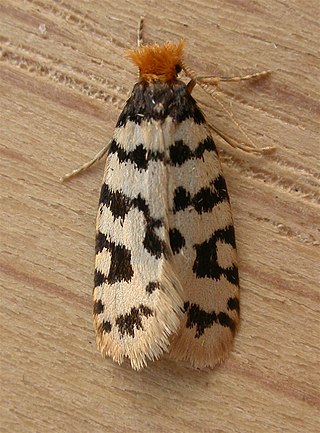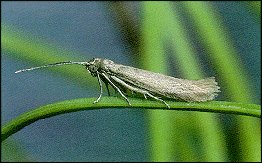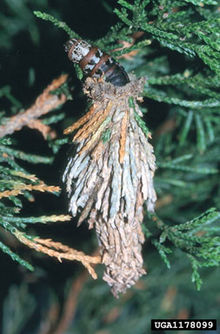
The Psychidae are a family of the Lepidoptera. The bagworm family is fairly small, with about 1,350 species described. Bagworm species are found globally, with some, such as the snailcase bagworm, in modern times settling continents where they are not native.

A pupa is the life stage of some insects undergoing transformation between immature and mature stages. Insects that go through a pupal stage are holometabolous: they go through four distinct stages in their life cycle, the stages thereof being egg, larva, pupa, and imago. The processes of entering and completing the pupal stage are controlled by the insect's hormones, especially juvenile hormone, prothoracicotropic hormone, and ecdysone. The act of becoming a pupa is called pupation, and the act of emerging from the pupal case is called eclosion or emergence.

The luna moth, also called the American moon moth, is a Nearctic moth in the family Saturniidae, subfamily Saturniinae, a group commonly named the giant silk moths.

Helicoverpa zea, commonly known as the corn earworm, is a species in the family Noctuidae. The larva of the moth Helicoverpa zea is a major agricultural pest. Since it is polyphagous during the larval stage, the species has been given many different common names, including the cotton bollworm and the tomato fruitworm. It also consumes a wide variety of other crops.

The apple maggot, also known as the railroad worm, is a species of fruit fly, and a pest of several types of fruits, especially apples. This species evolved about 150 years ago through a sympatric shift from the native host hawthorn to the domesticated apple species Malus domestica in the northeastern United States. This fly is believed to have been accidentally spread to the western United States from the endemic eastern United States region through contaminated apples at multiple points throughout the 20th century. The apple maggot uses Batesian mimicry as a method of defense, with coloration resembling that of the forelegs and pedipalps of a jumping spider.
Hymenoepimecis argyraphaga is a Costa Rican parasitoid wasp whose host is the spider Plesiometa argyra. The wasp is unusual in modifying the spider's web building behavior to make a web made of very strong lines designed to support the wasp's cocoon without breaking in the rain.

The codling moth is a member of the Lepidopteran family Tortricidae. They are major pests to agricultural crops, mainly fruits such as apples and pears. Because the larvae are not able to feed on leaves, they are highly dependent on fruits as a food source and thus have a significant impact on crops. The caterpillars bore into fruit and stop it from growing, which leads to premature ripening. Various means of control, including chemical, biological, and preventive, have been implemented. This moth has a widespread distribution, being found on six continents. Adaptive behavior such as diapause and multiple generations per breeding season have allowed this moth to persist even during years of bad climatic conditions.
The spitfire sawfly is a hymenopteran insect found in Australia. It is up to 22 mm long, has two pairs of wings, with a wingspan up to 40 mm, and its wings are honey colored. Its larvae are up to 80 mm long and somewhat resemble a caterpillar.
The wattle bagworm is a species of moth in the family Psychidae. In southern Africa it is a pest of the black wattle which is grown largely as a source of vegetable tannin. Kotochalia junodi is indigenous to Southern Africa, where it originally fed on indigenous relatives of the wattle.
Eumeta crameri is a bagworm moth of the family Psychidae. It was described by John O. Westwood in 1854 and has worldwide distribution in tropical and subtropical habitats, including India, Bangladesh, Sri Lanka, New Zealand and Puerto Rico.

The saddleback caterpillar is the larva of a species of moth native to eastern North America. It is also found in Mexico. The species belongs to the family of slug caterpillars, Limacodidae.

Papilio demodocus, the citrus swallowtail or Christmas butterfly, is a swallowtail butterfly which commonly occurs over the entirety of sub-Saharan Africa, including Madagascar, besides the southern Arabian Peninsula. The caterpillars feed on various native plants of especially the family Rutaceae, but have also taken to the leaves of cultivated citrus trees.

Galleria mellonella, the greater wax moth or honeycomb moth, is a moth of the family Pyralidae. G. mellonella is found throughout the world. It is one of two species of wax moths, with the other being the lesser wax moth. G. mellonella eggs are laid in the spring, and they have four life stages. Males are able to generate ultrasonic sound pulses, which, along with pheromones, are used in mating. The larvae of G. mellonella are also often used as a model organism in research.

Coleophora laricella, the western larch case-bearer, is a moth belonging to the family of case-bearing moths Coleophoridae. It is native to Central and Northern Europe, with its original food source being the European larch or Larix decidua. However, it was introduced to North America in the mid-19th century where it has gained a wide range and become an invasive defoliater of several species of the genus Larix, particularly the western larch Larix occidentalis and the tamarack larch Larix laricina.

Cadra calidella, the dried fruit or date moth, is a species of snout moth in the genus Cadra and commonly mistaken for the species Cadra figulilella. It thrives in warmer conditions and is found primarily in Mediterranean countries, although it can also be found in Central Asia, Kazakhstan, Transcaucasia, Caucasus, and the western part of Russia. It feeds on dried fruits, carobs, nuts and seeds, hence earning its colloquial name. This diet damages the food industry, and it is a common storage pest. Because of this, much research has been done to study ways to limit its reproduction rate and population size. It was first described by Achille Guenée in 1845.

Lymantria dispar dispar or LDD moth, commonly known as the gypsy moth, European gypsy moth, North American gypsy moth, or spongy moth, is a species of moth in the family Erebidae that is of Eurasian origin. It has a range that extends over Europe, Africa, and North America.

Liothula omnivora, the common bag moth, is a psychid moth endemic to New Zealand. It is also known by several Māori vernacular names like the tūngou ngou,< whare atua or kopi ('shut').

Hypera postica, commonly known as the alfalfa weevil, is a species of beetle in the superfamily Curculionoidea; it can be found in alfalfa fields throughout Europe. Considered a destructive threat to alfalfa production in North America, several accidental introductions have been successfully countered though the use of a variety of biological control species.

The lemon tree borer, also known as the whistling beetle or the singing beetle, is a longhorn beetle endemic to New Zealand. Its larvae are generalist feeders, boring into the wood of a wide variety of trees, native and introduced. When citrus orchards were first established in New Zealand, this beetle started inflicting serious damage, and so gained the name "lemon tree borer". Four species within the genus Oemona have been identified, suggesting that more species could be found. When disturbed by predators or humans, the adult beetle stridulates creating a "rasp" or "squeak" sound by rubbing its thorax and head together against an area of thin ridges. Māori would eat a liquid called "pia manuka", which was produced by manuka trees when its wood was damaged by the larvae. When Captain Cook first arrived in NZ, his naturalists, Banks and Solander, collected a lemon tree borer in their first collection between 1769 and 1771. This oldest collected specimen can be found in the British Museum. A few years after the first collection, the species would be first described by the Danish naturalist Fabricius in 1775.
Mahasena corbetti, the coconut case caterpillar, is a polyphagous species of bagworm. This species is classified as leaf-eating pest caterpillars that produce tough silk out of their bags from dried foliage. Currently, M. corbetti is considered a ‘pest of quarantine importance’ in multiple countries and is included on the list of dangerous pests in the Malaysian plant quarantine act.


















